Dairy farmer to sell home-built GPS and nutrient mapping tool
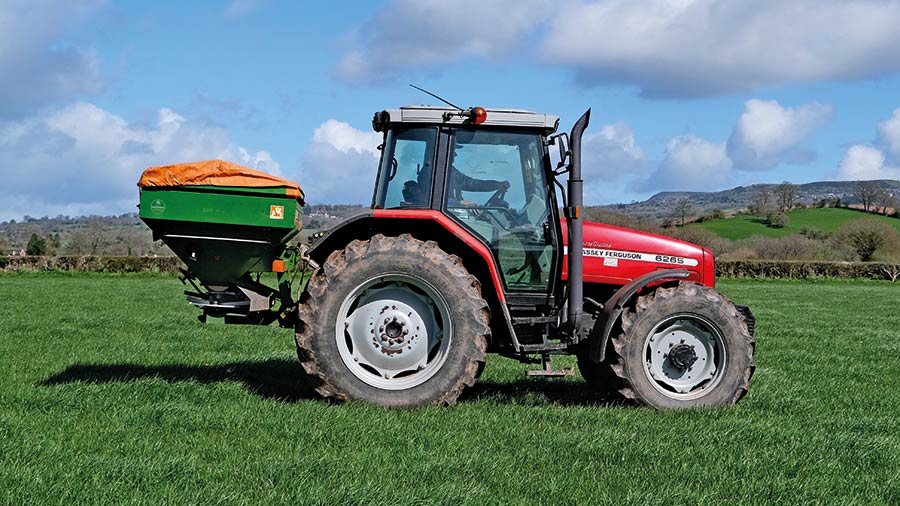 © James Andrews
© James Andrews Uninspired by the array of off-the-shelf tractor guidance systems, County Tyrone dairy farmer Andrew Wright set about building one to suit his own requirements.
A key reason for him going it alone was the considerable cost savings on offer, but he also wanted to get to the bottom of how these systems work, rather than just buying into the technology.
See also: How to build your own tractor autosteer system for £700
Another benefit was the fact that he could add as many custom features as he wanted, without having to shell out on costly unlock fees and ongoing subscriptions.
To most, this would seem an insurmountable task, but Mr Wright has a natural affinity with electronics and has spent years honing his skills.
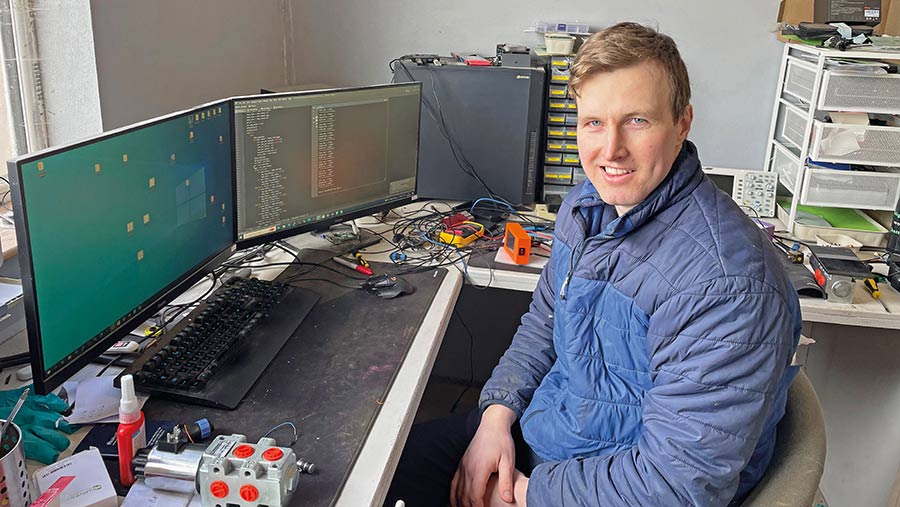
Andrew Wright @ James Andrews
Remarkably, he has done so with no formal training, instead teaching himself how to design circuit boards, programme computers and run a 3D printer to produce his own parts.
This has all had to fit in around his day job, running the 130ha family farm with 180-cow dairy herd in partnership with his father.
The GPS system is the latest in a long line of electronic exploits, most which have been for his farm. However, off the back of these successes, he’s formed a secondary business called FarmTheory.
Through this he takes on bespoke projects for other farmers and machinery manufacturers, as well as selling his GPS system.
This is a relatively recent development that came about after sharing much of his work on social media, leading to several of his subscribers asking if they could buy one.
Kits are priced at £2,500, including a 4G sim card with two years’ worth of data for connecting to an NTRIP RTK network. They also come with a two-year warranty and two years’ worth of free updates.
Although the systems are fully functioning and 15 models are now out and working on farms, Mr Wright still classes it as a “beta” version, meaning updates and tweaks are ongoing.
Over the next couple of years, he plans to hone the design so that it can be sold on a larger scale.
The most obvious feature he’s yet to add is autosteer, but he says this is in the pipeline.
It is likely to come in the form of a steering wheel adaptor that can be bolted on without any need to tap into the tractor’s hydraulic or electrical systems.
GPS development
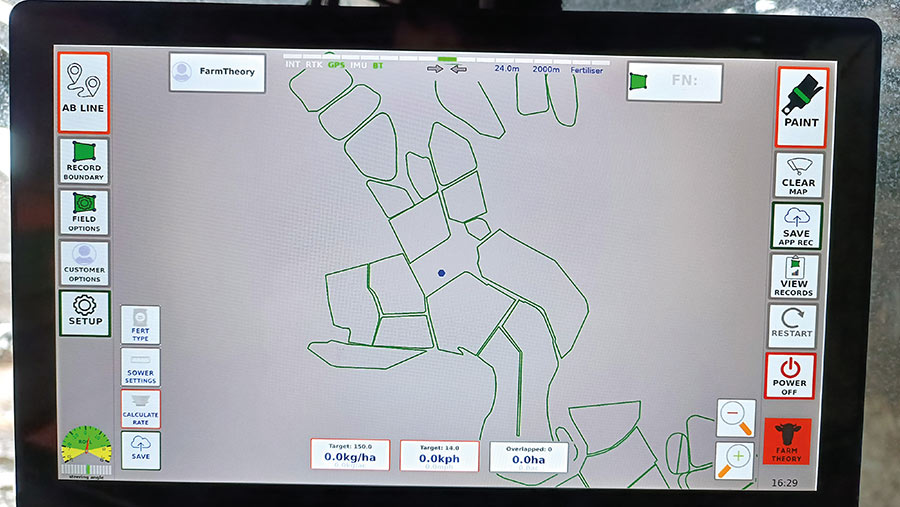
© James Andrews
When Mr Wright embarked on the GPS project, he decided from the outset that it would be all his own work.
Other farmers who have put their own systems together generally make life easier for themselves by using free AgOpenGPS software, which can be loaded on to a tablet.
His solo approach meant he had to programme his own software from scratch, as well as assemble the in-cab terminal from an assortment of component parts.
The benefit is that he can quickly find any problems, rather than having to seek help from others. But it made it much more time-consuming.
After about five years of development, the odd frazzled circuit board, and a couple of fully functioning prototypes, he came up with the current FieldTheory version.
Free RTK
A notable difference between Mr Wright’s GPS and many of the units from the big names is that it comes free with the ability to receive an RTK correction signal.
This means it offers pass-to-pass accuracy of 10cm or less and has a more stable signal than satellites alone, particularly in hilly regions.
Users can connect to any NTRIP RTK signal, some of which are now free, or install their own base station.
Mr Wright has one of these at his own farm near Omagh that any user can connect to, and he’s planning to have the whole of Northern Ireland covered in the next couple of years.
All of these will be free to access, so buyers won’t have to pay any ongoing fees, other than their 4G mobile sim card.
For those that can’t access RTK, the GPS unit will happily run on free satellites such as Egnos and Glonass. The signal just isn’t as stable or accurate.
Smart features
When used at its most basic level, the tool offers A-B line guidance, allowing drivers to follow direction markers on the screen, with the worked area being coloured in as they go.
However, there are options to record field boundaries and guidance lines, so that they can be worked in the same way year after year.
One particularly clever feature is the ability to record a boundary without having to drive around the headland.
Like top-end guidance systems, fields are automatically recognised when driven into, so there’s no need to waste time searching for them.
There are also some more advanced features on offer, which are designed to make life easier for livestock and mixed farmers that don’t have farm management systems.
One is a nutrient management tool that records fertiliser applications and colour-codes fields according to their condition.
For example, those that are designated red for nitrogen need an urgent top up, while those graded amber will soon be due a dose.
The system works this out by recording the quantities and dates of nitrogen applications, before subtracting the amounts grass will use over time. It’s only an estimate, but Mr Wright says it is surprisingly accurate.
Users can also keep tabs on phosphorus and potassium indices by uploading soil test results and the program also takes account of manure applications, working off test results or using a series of stock values for untested products.
Development is ongoing, so more features will be added over time. Mr Wright’s aim is to make these as simple as possible, so farmers don’t have to spend hours learning how to use them or spend inordinate amounts of time entering data.
Another neat feature is job management, which allows farmers and contractors to keep digital records of all the work they do.
Just like systems from the big-name brands, these records can be emailed to a phone or office computer using the inbuilt 4G internet.
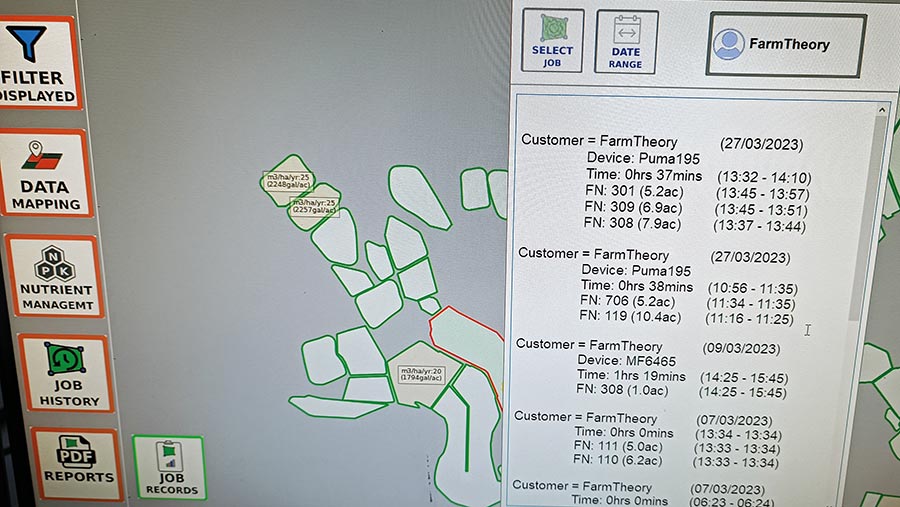
© James Andrews
Custom-built terminal
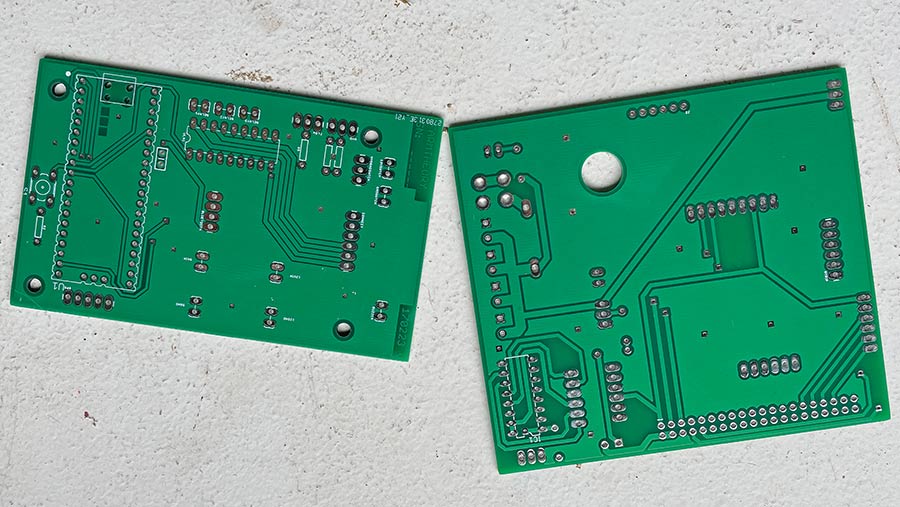
Custom printed circuit boards © James Andrews
Many lower-cost GPS systems work off a tablet, but Mr Wright thought he could build a custom terminal that would work more efficiently.
This approach also meant he could house all components in one neat box, leaving just the roof-mounted GPS antenna and, if used, the 4G RTK receiver to be mounted externally.
To achieve this, he sourced a suitable high-quality touchscreen display, designed and assembled a bespoke circuit board and developed his own software that runs off a Raspberry Pi mini computer.
He even designed the casing, which he produces in his office on a 3D printer.
Other projects
Mr Wright’s electronic wizardry extends well beyond his GPS system, with an extensive catalogue of kit built for his own farm and for others.
Slurryquip flow controller
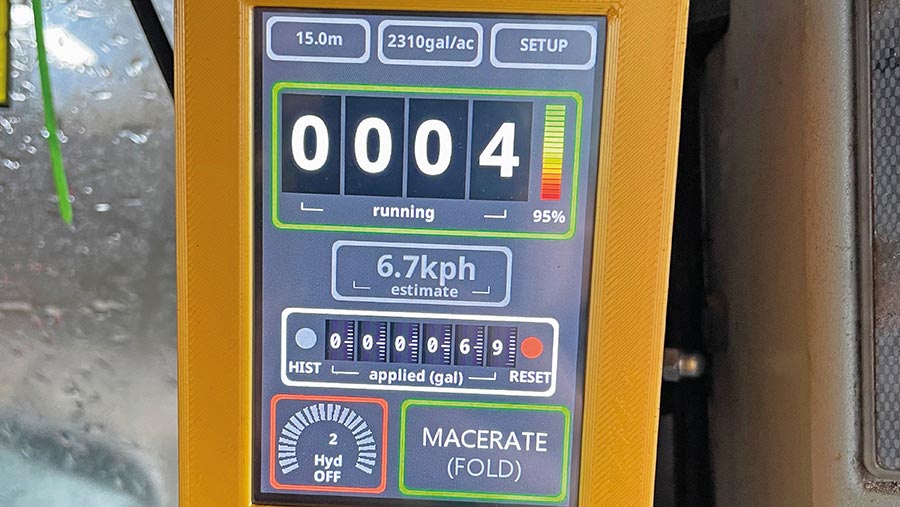
Slurryquip control box © James Andrews
Off the back of his GPS success, he was approached by Slurryquip to produce a device that would display and record the amount of slurry applied through its dribble bars.
The umbilical version gives a digital readout of how much slurry is going through the flow meter and, by entering the desired application rate, operators are given a target speed to drive.
The addition of a Bluetooth module means the box can share data with Mr Wright’s GPS system, allowing it to be included in his nutrient management tool.
There’s also a function that allows operators to electronically switch between running the macerator and folding the dribble bar, without having to get off the seat.
The tanker version operates in a similar way, but works out the target speed based on how long it takes the tank to empty, rather than how much slurry is passing through a flow meter.
It also has a hydraulic sensor so that there’s no need to switch the recording on and off manually.
Both units are available to buy through Slurryquip.
Cattle water intake detector
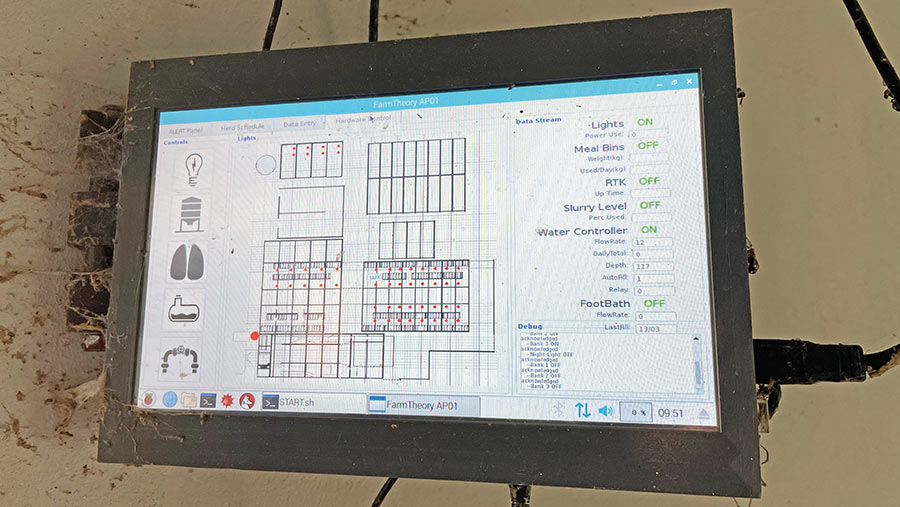
Dairy management system © James Andrews
Keen to assess the effect of cattle water intake on daily weight gain, a local cattle farmer approached Mr Wright and asked if he could develop a system to record it.
He soon came up with a solution, which involved fitting an EID reader at the water trough and a flow meter on the ball cock.
This means that each time an animal comes to drink, it is identified and the amount of water it takes out of the trough is recorded.
To make sure multiple animals weren’t being recorded, he ensured there was a narrow enough entrance so that only one could fit at a time.
Results are still being assessed, but it looks likely that water intake is a good indicator of weight gain, with those that drink the most putting on the most weight.
Milk Check app
Fed up with how difficult it is to compare milk contracts from different dairies, Mr Wright came up with an app that takes out the hard work.
The aptly named Milk Check app is free to access on Android devices and cuts through all the complex pricing structures employed by dairies so that farmers can get a clear picture of what sort of deal they’re getting.
All that Mr Wright requires to calibrate the system is one milk cheque from each dairy. It’s still in development, but already works for Dale Farm and Lakeland farmers.
Others will be added when he gets access to some more milk cheques.
Smart dairy
Over the past five years Mr Wright has introduced several pieces of technology to improve the efficiency of the farm’s dairy.
One of the areas he’s focused on is energy consumption, as it’s one of his biggest costs.
By building systems to carefully monitor usage, he was able to pinpoint his hot water heater as the biggest power sapper, accounting for a whopping 55% of the farm’s total energy cost.
Simply by changing the timing of the heating so that it kicks in on a cheaper night-time tariff, he was able to save £600 a year.
Also, by making sure the heating process finished just before the water was needed, he minimised heat loss and shaved off another £200/year.
Similarly, increasing the temperature of the milk bulk tank, from 3C to 5C, saved £200 a year.
In a further drive to cut costs, he’s built automated systems for most processes in the dairy, from light switching and footbath filling, to milk yield recording and feeding.
For the latter, he assembled a bespoke parlour feeding system that gives each cow a targeted ration.
This cut the feed bill so dramatically that it covered the repayments on a new 40/40 parlour, without having an adverse effect on milk yield.

